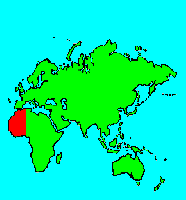SPECIES INFO
Plain Swift (Apus unicolor) is found on the Canary and Madeira Islands. This has been recorded along the coastal area of northwestern Africa as far north as Gibraltar. This 14 centimeter (almost 6 inch) swift is mostly brown. The pale throat area is very small.
There are no subspecies.The true swifts genus (Apus) is found widely in the Old World This is found widely from Europe to Asia and south into much of the Indo-Australia region. This genus is also found widely in Africa. There are 15 species. Wings are somewhat tapered, and their flight is powerful.
The Apodinae swifts comprise the majority of the swift family. There are about 81 species in this subfamily. The following genera are included:
Hydrochous (1) Malaysia to Java
Callocalia (3) Indonesia, Philippines, New Guinea, Solomons
Aerodramus (22) Seychelles, SE Asia, Indonesia, S. Pacific
Schoutedenapus (2) Africa
Mearnsia (2) Philippines to New Guinea
Zoonavena (3) Madagascar to India
Telacanthura (2) Africa
Rhapidura (2) SE Asia, Java, Africa
Neafrapus (2) Africa
Hirundapus (4) East Asia to Indonesia
Chaetura (11) New World
Aeronautes (3) New World
Tachornis (3) New World Tropics
Panyptila (2) New World Tropics
Cypsiurus (2) Africa, Asia, Indonesia
Tachymarptus(2) Europe and Africa
Apus (15) Asia, Africa, Indonesia
These swifts generally have cigar shaped bodies. They fly faster and are more acrobatic than swallows. Swallows will land on a telephone wire, but swifts can be found clinging to various vertical rock surfaces.
Swifts (Family Apodidae) are a small worldwide family of birds The sixty-seven species mentioned in Singer are widespread around the world. The species count was increased to 99 in 1993 by Monore & Sibley. And in 2003 in the Howard and Moore organization, they counted 94.
Swifts are a family of very fast-flying birds. Some species can fly at speeds up to one hundred miles an hour. These generally are small dark colored birds and include some of the best flying acrobats. They generally catch insects on the wing.
This family can be broken into two subfamilies as follows:
Cypseloidinae (13)
Apodinae (81)
(The tree swifts, family Hemiprocnidae, are usually treated separately.)
Swifts and Hummingbirds (Order Apodiformes) are combined into a single order. Both families have excellent flying abilities. The swifts are known for their speed, and the hummingbirds for their ability to hover.
Clements in 2007 listed 100 swifts, 4 treeswifts, and 339 hummingbirds. (Total of 443 species.)
Aves contains about 8,650 different species of living birds known to science. Each year about one new species is discovered in some remote rain forest or remote island. In addition, scientists have been raising many subspecies to full species status which may raise the species count to 10,000. Birdlife recognizes 10,027 species as of 2011.
However, each year about one species goes extinct. The rate of extinction is increasing, and the rate of new discovery is decreasing, so that the number of bird species will soon begin to decline rapidly. Although different taxonomists would organize the birds differently, there are approximately twenty-seven orders of birds. These orders are broken down into about one hundred and fifty-five different families.
Recent research of the genetic structure of some of the shore birds and owls would indicate that the present organization of orders and families should have some modification.
The birds are a worldwide group of animals that are characterized by having the front limbs modified into wings that are used for flying. Perhaps the most unique feature of the birds is the feathers. These feathers are made up of a central support called a quill and a series of small filaments that are hooked together as barbs.
For many years it was believed that Archaeopteryx discovered in Bavaria was the oldest bird from about 150 million years ago. However, in l986, Sankar Chattterjee, a Texas paleontologist, reportedly discovered a bird in the genus Protoavis that lived about 225 million years ago.
When this project was begun in 1978, we used Austin & Singer for bird taxonomy. Since then, we have adopted many changes, but have kept some older concepts that are still found widely in the literature. Recently, we have used Clements and Howard & Moore. Very recently, we have used Monroe and Sibley for the higher taxonomy of the perching birds.
Backboned Animals (Phylum Chordata) are the most advanced group of animals on earth. These animals are characterized by having a spinal cord or backbone. Most members have a clearly defined brain that controls the organism through a spinal cord. Fish, amphibians, reptiles, birds, and mammals are in this phylum.
Currently, some taxonomists believe that the fish should be divided into two groups (sharks and regular fishes) and that there are some other primitive groups in the phylum such as hagfish or lampreys.
Animal Kingdom contains numerous organisms that feed on other animals or plants. Included in the animal kingdom are the lower marine invertebrates such as sponges and corals, the jointed legged animals such as insects and spiders, and the backboned animals such as fish, amphibians, reptiles, birds, and mammals.


